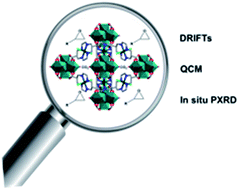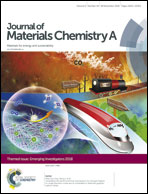Insights into CO2 adsorption and chemical fixation properties of VPI-100 metal–organic frameworks†
Abstract
Metal–organic frameworks (MOFs) have shown great promise as efficient CO2 adsorbents, as well as an emerging class of heterogeneous catalysts for conversion of CO2 to other useful chemicals. In this work, we synthesized and characterized two isostructural hafnium-based MOFs, denoted as Hf-VPI-100 (Cu) and Hf-VPI-100 (Ni). Both frameworks demonstrated high catalytic efficiency for cycloaddition of CO2 to epoxides under ambient pressure. In situ PXRD, QCM and DRIFTs have been used to probe the interaction between the guest molecules (CO2/epoxide) and Hf-VPI-100. The crystal structures of these frameworks were preserved during the exposure to CO2 atmosphere up to 20 bar. The epoxide uptake per unit cell of VPI-100 and diffusion coefficients have been calculated by QCM analysis. Comparison of catalytic efficiency between Hf-VPI-100 and the previously reported Zr-based VPI-100, aided by electronic structure calculations revealed that the open metal centers in the metallocyclam act as the primary Lewis acid sites to facilitate the catalytic conversion of CO2.

- This article is part of the themed collection: Journal of Materials Chemistry A Emerging Investigators


 Please wait while we load your content...
Please wait while we load your content...